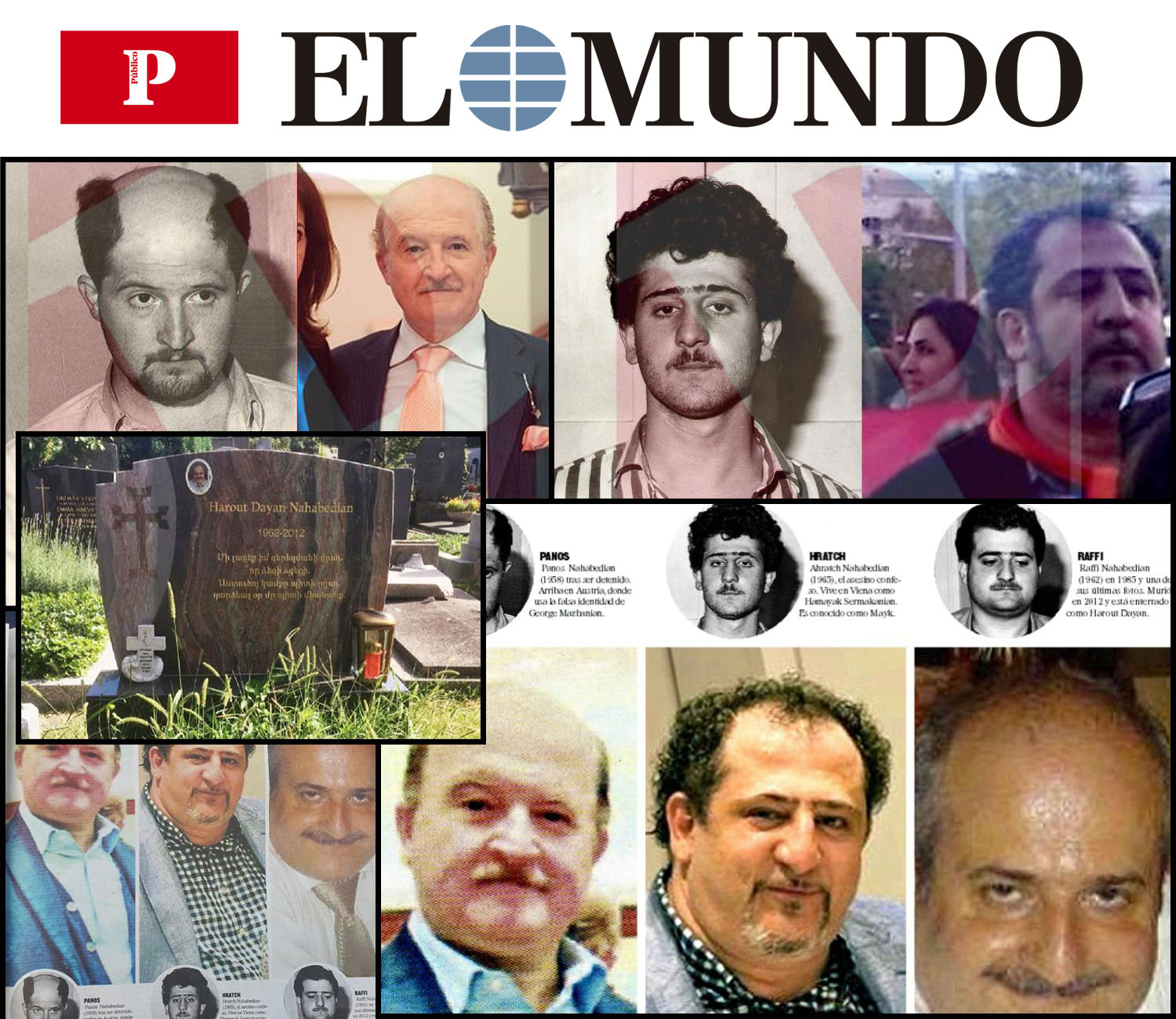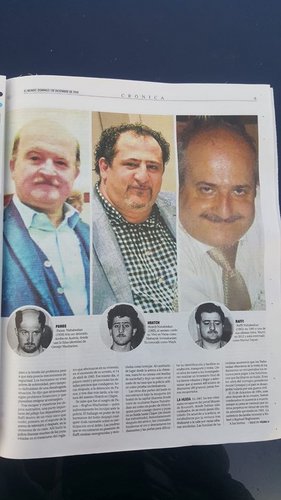In December 2019, the spanish El Mundo newspaper, and Publico website, published the following article signed by journalist Ferran Barber:
INVESTIGATION. We have found the authors of the massacre of Bourj Hammoud -the greatest robbery in the history of Lebanon and the Middle East. They stole two million dollars in jewels, gold and cash in 1985. They killed five people to get the loot and today, they are living as apparently respectable jewellers in Vienna. But the truth about them is that they are, in fact, the main characters of a crime without punishment. They got Austrian nationality with false identities and never paid for their crimes. The fingerprint has identified the material author of the deaths.
The old crime scene photographs leave no doubt about the cold blood of the three Lebanese brothers with Armenian roots - Hratch, Panos and Raffi Nahabedian - who committed the most heinous robbery in the history of the country of the cedars at past two-thirty in the afternoon of March 28, 1985. The court verdict that years later sentenced them to death - commuted to life imprisonment - assumed that the youngest of them - Hratch Nahabedian - liquidated, one after another, the co-owner of the jewellery store and four of his employees with a 6.35 mm gun equipped with a silencer. He didn't even blink when Interpol agents stopped him, on April 17 of that same year, in neighboring Cyprus.
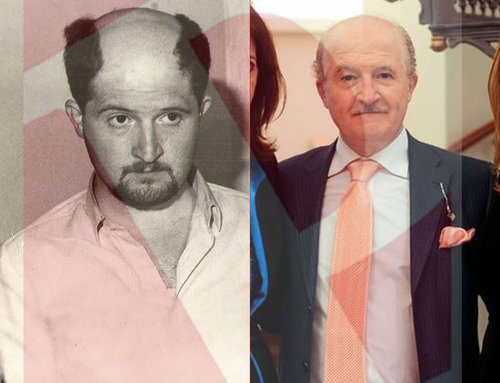
On the left, Panos Nahabedian, in a 1985 mugshot, and on the right, a recent image at Mazbani jewelry store in Vienna. In Beirut he shaved his skull to escape the police, and life has deprived him of hair following a similar pattern.
According to his own confession, Hratch Nahabedian (b., November 8, 1965) killed them all, while his two brothers Panos (b., March 30, 1958) and Raffi Nahabedian (b., June 6, 1962 ) looked out and emptied the safe. A downward estimate made by Al Safir daily newspaper valued the stolen gold, pearls, cash and diamonds at twenty million 1985 Lebanese pounds (about one million and three hundred thousand dollars). The descendants of the victims agree to claim today that two million dollars in objects were stolen.
Both the murdered jeweller Hrant Kurkdjian and his partner Robert Boghossian - absent during the robbery - were well known in the Armenian district of Bourj Hammoud, where their business was located. Three thousand people were employed by them as goldsmiths, and among them, the criminals themselves, which explains why they went through the store without opposition despite it had security mechanisms. The brothers were not poor in solemnity, but they did not enjoy a comfortable situation. The judicial summary that was instructed pointed out that they were going through some financial problem and that they planned to emigrate abroad.
Shortly before the robbery, several Beiruti jewellers had entrusted large quantities of precious stones to the murdered Hrant Kurkdjian and his partner Robert Boghossian, also known interchangeably by the name of Raphael. Was it a mere coincidence? After their imprisonment, the criminals tried to make Justice believe that they were encouraged by Robert Boghossian (1923-2012), the co-owner of the business. Before mentioning his name to the police, they tried to extort him.
After escaping the jewellery and handing out the loot, a significant part of the pillage was hidden by Raffi inside an old sack that camouflaged, first, at the base of a television antenna and some time later, in the fireplace of his house. It was just there where the loot was found by the Lebanese police during the search they made at his home, at the time of his arrest, on April 14, 1985. That same day, the bird sang, providing the precise details that hours later led to the arrest of Panos, and three days later, to the capture of Hratch in Cyprus.
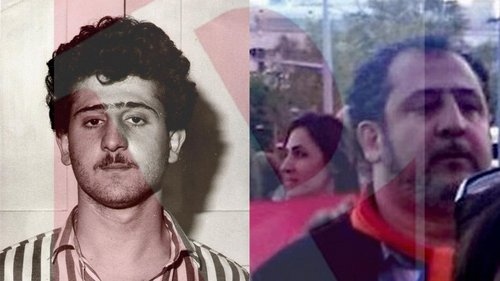
On the left, Hratch Nahabedian, in a 1985 mugshot. On the right, a recent photo participating in the Armenian Genocide commemoration in Vienna, in 2015.
According to the summary instructed by the police, it is assumed that it was Panos' father-in-law - Boghos Mazbanian - who accused them before the police. In the eyes of the Beiruti police and the Lebanese court, the spoils found in the hands of the three Armenian brothers and their escape after the robbery cleared any reasonable doubt about their participation in the crime. The stones found in Raffi's possession were blackened and mixed like lentils inside the old sack. When changing it from the antenna to the fireplace, the Armenian stained his shirt with traces of dirt and left a trail on the floor of his house that the police used as incriminating evidence.
The other two parts of the loot were found under the carpet of the Beiruti hostel where Nahabedian Panos tried to hide as well as in the hands of Hratch, who carried money and jewelry with him on his escape to Cyprus. Immediately after the robbery, the criminals melted the gold and discarded the diamonds and the pearls to hinder their identification and facilitate their concealment, transport and sale. It took five years for researchers to have a final inventory of stolen goods and determine that at least 400 carats of diamonds (80 grams) were never recovered.
Nine years after the robbery, on December 10, 1994, they were sentenced in absentia to death, although their sentence was commuted to life imprisonment under an amnesty law passed in 1991. That same sentence declared Robert or Raphael Boghossian innocent. How did the three Armenian brothers evade the action of Justice in their country? Escaping from the prison where they were confined.
The families of the victims take it for granted that the Nahabedians obtained the necessary resources to pay the prison officials who facilitated their escape from the prison by selling the spoils in the black market. It happened during the years of the former corrupted President, Amine Gemayel and the country was still bleeding from civil war. The way in which the three criminals escaped in 1987 from the Lebanese prison in Roumieh was never elucidated. According to the Lebanese police, they sneaked out the window and slipped down the street through some knotted sheets. The family of the victims considers this explanation to be a joke. In their opinion, “it would be more likely that someone would have provided them with a file hidden in a cake”.
Since their escape, no one could trace them as if the earth had swallowed them up, and nothing was ever known about the three convicted criminals outside of the Armenian gossip shops in diaspora, which attributed to them a thousand possible destinations. Panos Nahabedian made the families of the victims believe that he had died of cancer. Nothing is further from reality. During all these years, the three brothers had lives of unequal fortune in the Austrian capital, hidden behind the false identities with which they obtained Austrian nationality.
It has been thanks to the perseverance of the victims' descendants that it has been possible to find their trail. They have never stopped claiming justice while tracking the murderers' steps with the help of journalists, lawyers and friends. The murderers devastated their families and caused trauma that time has not healed.
Finding the three Armenian brothers convicted by a Lebanese court has not been easy. It was necessary to wait until 2013 for a chain of coincidences to bring to Beirut the rumor that there was at least one jeweller in the Austrian capital who had aroused suspicion in the Armenian community of Vienna for his possible links with the criminals of Bourj Hammoud. A thorough checking of all available censuses and directories did not initially provide any light.
But at the end of 2016, a surprising discovery was made with the collaboration of some friends of the victims. In the Margaretenstrasse cemetery in Vienna 1050, there was a tomb of someone whose photo revealed a striking resemblance to that of an aged Raffi Nahabedian. The name of Haroutioun Dayan Nahabedian could be read on the marble. That is, whoever rested in that grave carried one of his last names; the facial features and cranial characteristics were suspiciously similar and, it was brought to attention that the date of his birth was the same.
Was it a coincidence?
From the investigations subsequently carried out, it is inferred that whoever lay under that grave since December 12, 2012 entered Austria a few months after the escape of the criminals, in 1988, and obtained Austrian citizenship in 1992. The passport used by the dead suspect while he was still alive pointed out that the latter was born in April 1950, but surprisingly, 1962 was registered on the marble as the date of birth of the deceased. That is, the same as Raffi Nahabedian.
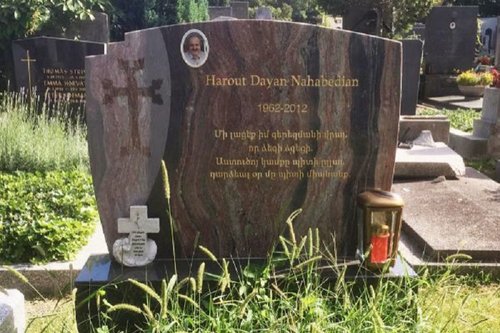
Gravestone of Raffi Nahabedian, buried under the name of Haroutioun Dayan. His real name is mentioned on the stone, and also the real year of his birth, 1962.
From that surprising discovery, it has been possible to find out that one of the sons of the man buried in the cemetery of Margaretenstrasse -born before the robbery in Beirut- is also living in Vienna and he's called as the first Raffi's offspring: Assadour Nahabedian.
What the relatives of the victims believe they are willing to prove is that Raffi Nahabedian lived until the date of his death in Vienna using the passport of an Armenian compatriot who is twelve years older than him. The fake Haroutioun Dayan worked in the Austrian capital for Anton Heldwein and Brüder Nowotny, before opening his own store, in 2006, on Gluckgasse Street. Raffi married Marie Alkhoury in Beirut. His wife divorced him after the robbery, but traveled to Austria after the flight of her ex-husband with the false name of Marie Dayan, and remarried Raffi again. It was a pantomime to get rid of surveillance. Both the imposter Haroutioun Dayan (Raffi Nahabedian) and his wife frequented the church often and pretended to be surrendered to the Holy Scriptures.
Not far from a shop closed down after the death of Raffi Nahabedian - run by the fake Haroutioun Dayan - there was and still exists another small jewellery with a more miserable appearance run by another Armenian called Hamayak Sermakanian. As it's been demonstrated by the Austrian police, the impostor Hamayak Sermakanian and the convicted author of the five murders are the same person. Actually, he is using his cousin's name and passport.
Unlike his brother Panos Nahabedian, Hratch does not seem to have done very well in Austria. It is known among the Armenian community in Vienna that he has not found a way to integrate. According to the Austrian police, he barely speaks German thirty years after his escape from Lebanon. He lives in a very poorly furnished apartment and his external appearance is often deplorable.
Hratch (Hamayak Sermakanian) has been seen in public events such as the commemoration of the Armenian Genocide (2015). The confessed author of the five murders has been also photographed in some social events organized by the Hovhannes Shiraz school. His fiancée in Beirut - Sonig Katourjian - traveled to Vienna on December 29, 1989, using the passport of a relative named Maggy Bezjian. They got married in Austria, and three children were born from that marriage.
The oldest of the three brothers entered the country in 1988 using the passport of a woman named Asdghik Mazbanian, who turned out to be his sister-in-law. The Austrian authorities never noticed that he used a female appellation and until 2005, Panos did not request that Asdghik's name be changed to George's. He argued then that he was encouraged by the pronunciation difficulties of the natives. From then on he became George Mazbanian. That is the name currently answered by the bald man who can be almost daily seen behind the windows of the business located at number 4 of Führichgasse street.
Indeed, Panos Nahabedian's fake last name is that of his sister-in-law and therefore, also, that of his wife. But then, how did his wife register and obtain Austrian nationality? According to the Austrian registry documents, she used the name of Seta Nahabedian. In other words, they exchanged their surnames and now Panos Nahabedian is George Mazbadian, while his spouse Seta Mazbanian has become Seta Nahabedian. Inside the jewellery that both run, his brother Hratch, can often be seen. Panos and Seta had a daughter with down syndrome, who died in 2002, and whose body is buried not far from Raffi's. Their second daughter is the nominal holder of their business, and the one that appears on the jewellery website. They even dedicate an epigraph to the history of family and business, and their long tradition as jewellers.
It is known that Panos and Hratch lived together upon their arrival in Vienna in 1988, in an apartment located on Rechte Wienzeile Street, and subsequently moved to Bacherplatz 4/4/8. The three Armenian brothers’ families occupy until today low-income housing provided by the Austrian Government in the same district. Also their three businesses are close to each other. Raffi's was closed in 2016, four years after his death, while Hratch is never seen inside his store - a small slum located on Akademiestr Street - since 2016. It was then when certain events revealed to him that Austrian security forces were on his heels as, in fact, it happened.
Three years ago, the relatives of the victims informed the Austrian authorities of the presence in their country of the three convicted and confessed criminals. As a result, Viennese officials performed a fingerprint test on the false Hamayak Semakanian. According to the document obtained by this newspaper, and sent by the Regional Brigade of Criminal Investigation of Vienna in February 2017, “the comparative investigations of the fingerprints have allowed to verify unequivocally and without any doubt that Hratch Nahabedian and Hamayak Semakanian are one and the same person ”, unfolded into two identities.
The Armenian brothers could still ignore that they have already been found because the investigations by the Austrian police have been carried out in secret. The agents who visited Hratch's house in order to perform an identifying fingerprint test never clarified to him the reasons that propitiated it. At this time, there are two red alerts or arrest warrants issued by the Lebanese Interpol office, requesting the arrest of the Armenian brothers Hratch and Panos.
Why hasn't the Austrian police intervened against them if, in fact, they have full knowledge of their true identity? In the first place, because there is no extradition agreement between the two countries. And secondly, because the prosecutor who has taken charge of the procedure for the crimes of homicide and aggravated robbery has made it clear that it won't be determined if the Nahabedian brothers should be prosecuted and judged again until the Beirut courts do not send a long list of documents and evidences related to the process that culminated in their conviction.
In the meantime, there is no indication that the Austrian police have subjected the perpetrators of the massacre to surveillance, or that they have expanded on their own the investigations on the Viennese terrain, while waiting for the Lebanese courts and authorities to attend their documentation requests in order to evaluate the case. It is known, however, that Beirut sent a copy of the fingerprints of the three convicted. The Austrian prosecutor's office that has taken charge of this case has never revealed whether she could take also any action against the two Armenian brothers and their families, due to the fact that they obtained Austrian nationality by impersonating identity and document falsification. The families of the victims are “perplexed and dismayed by the twisted bureaucratic exchange between the Austrian and Lebanese courts”.

